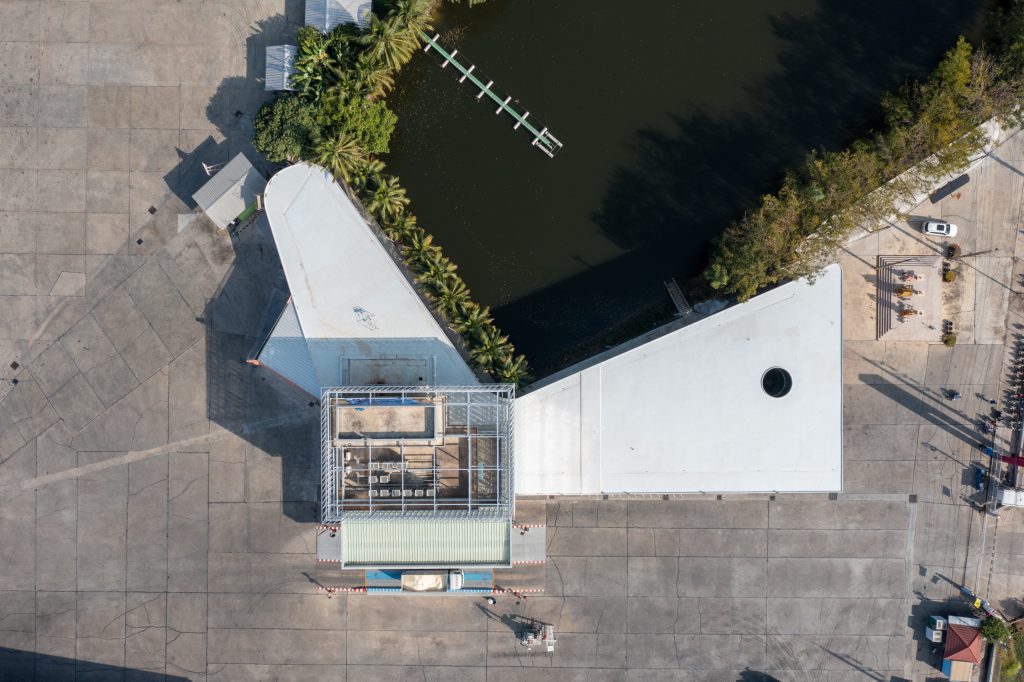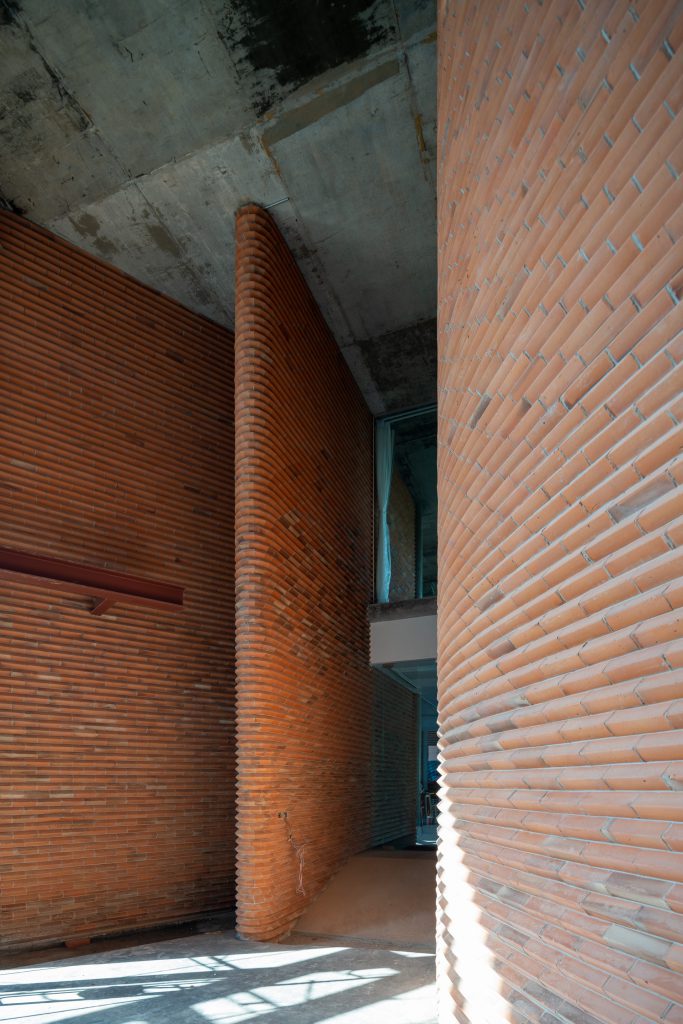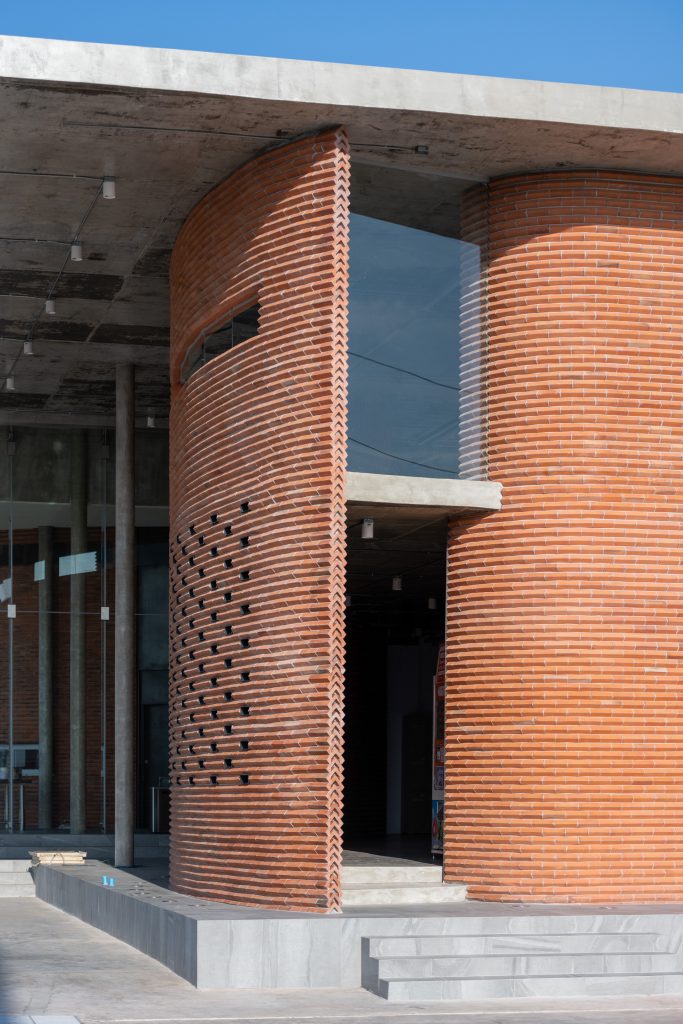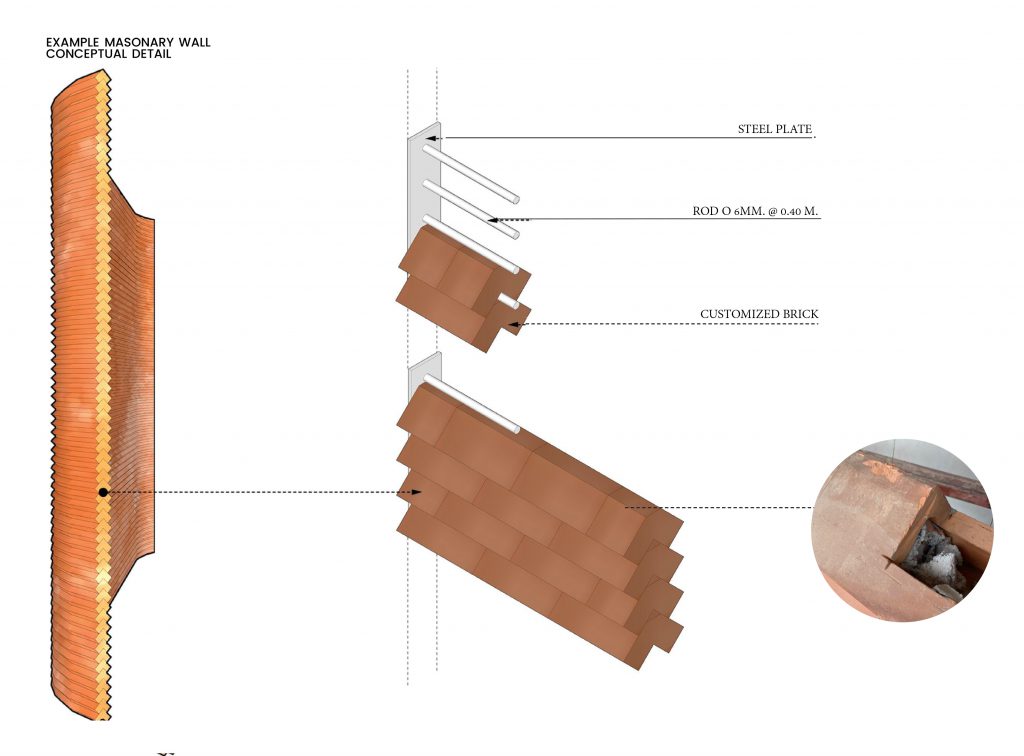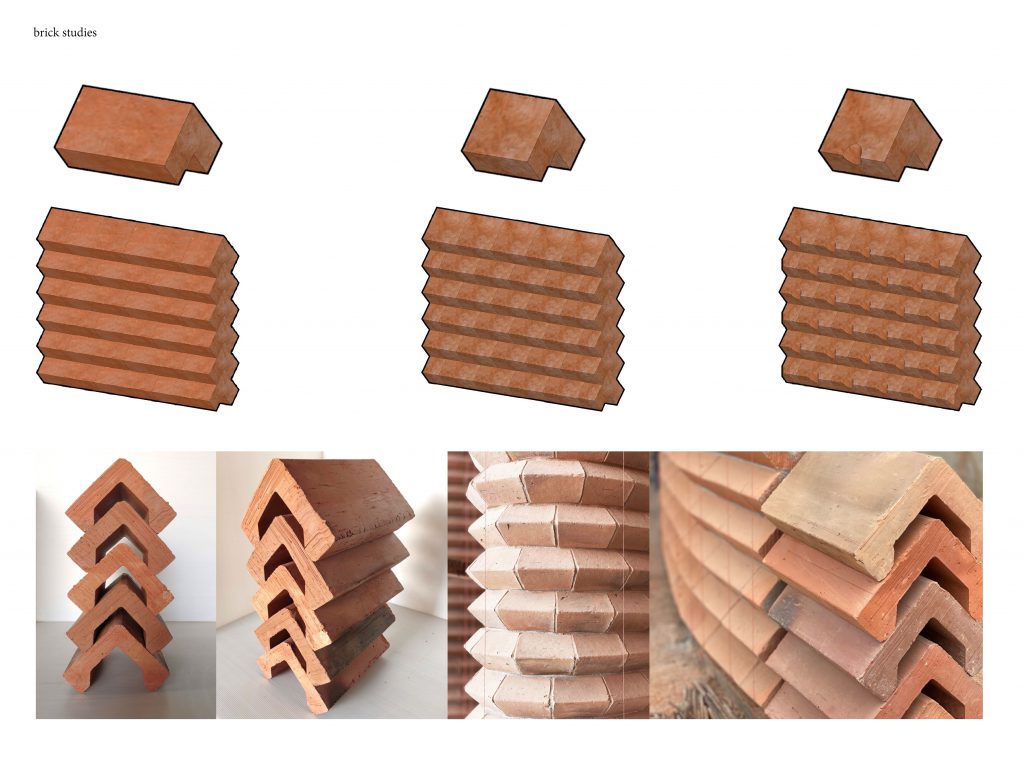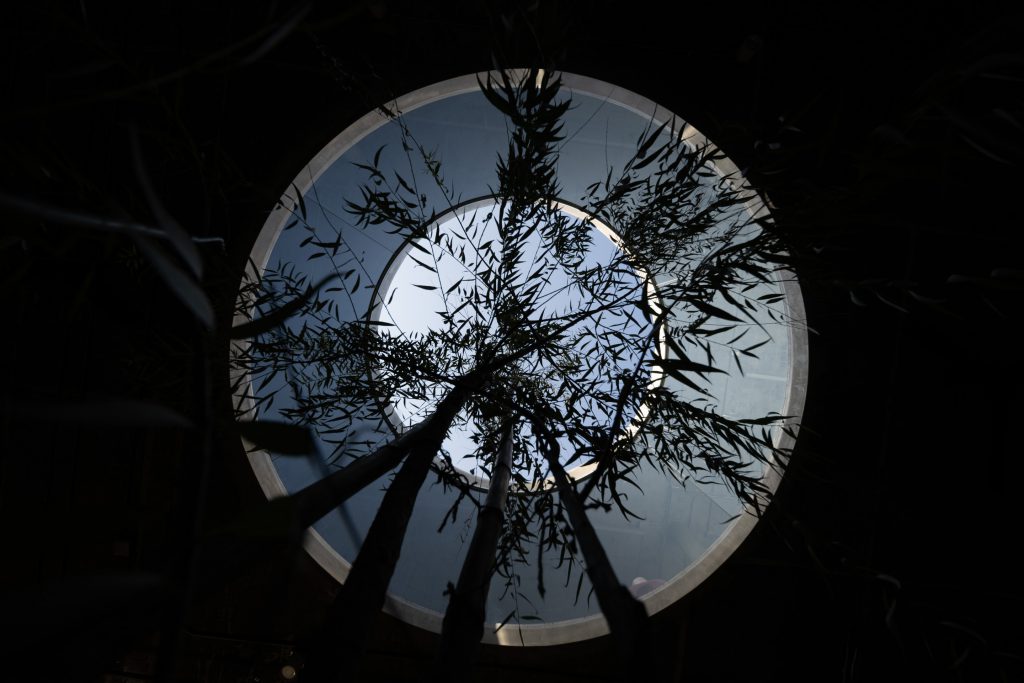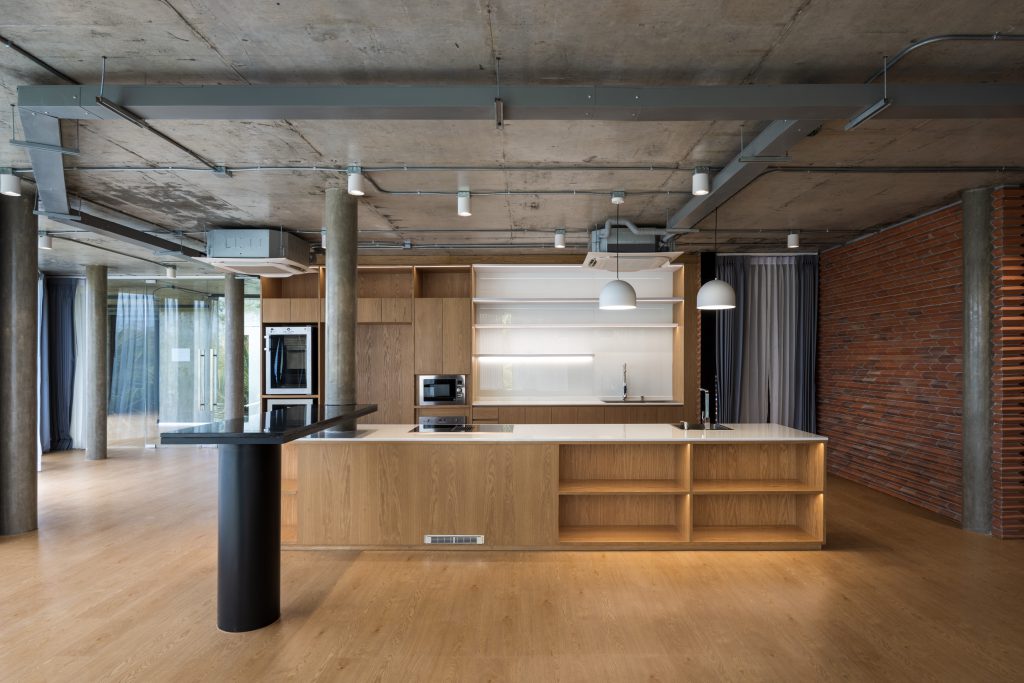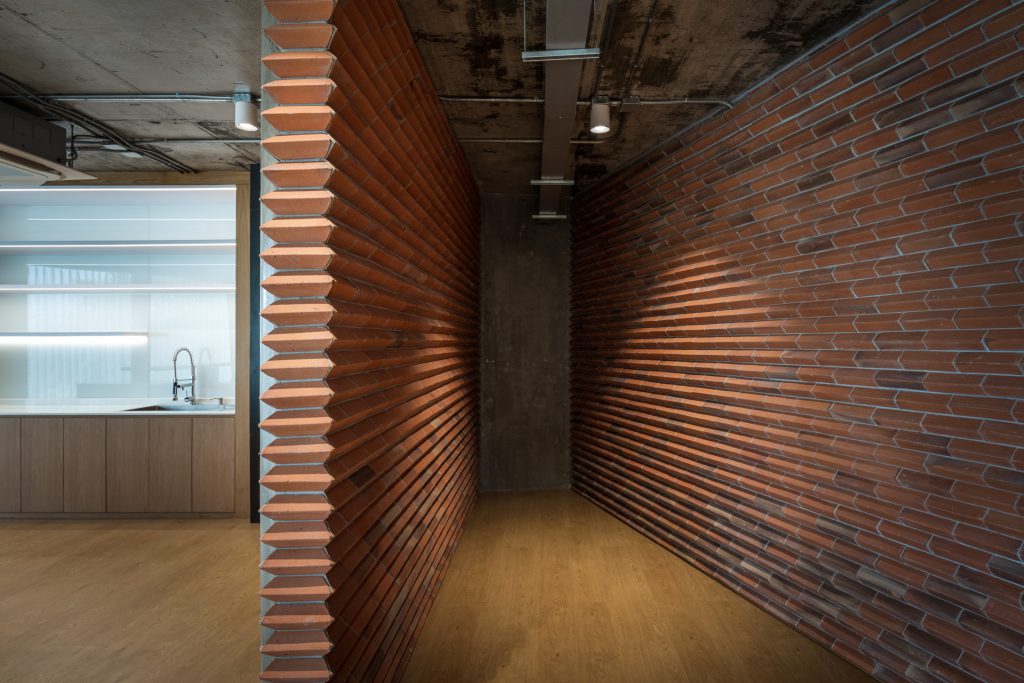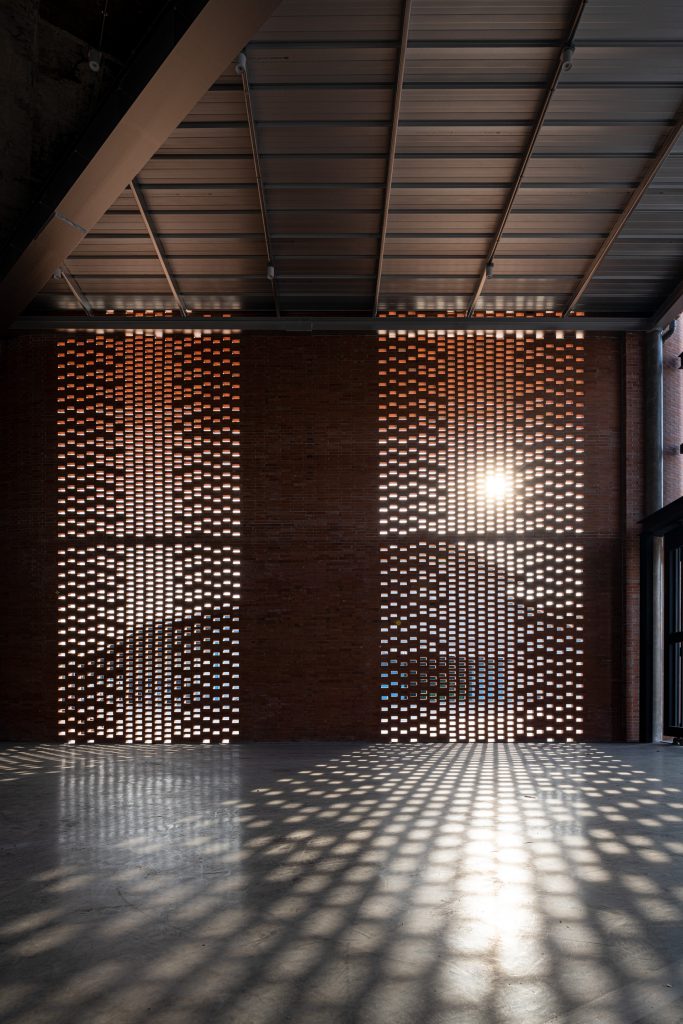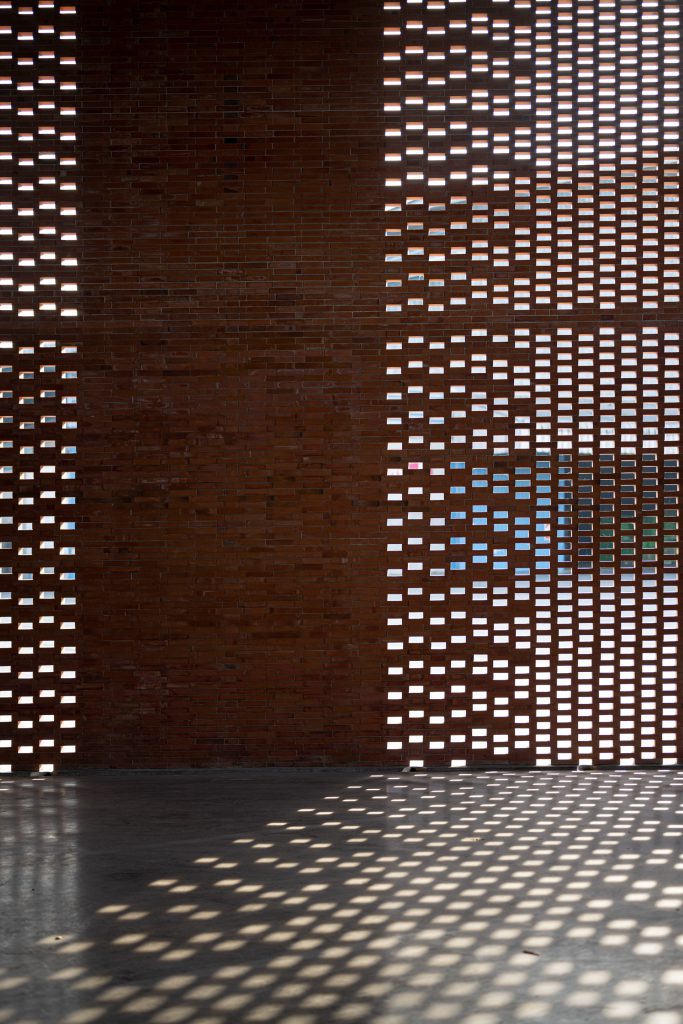With the help of light, the design for a prominent rice mill in Nakhon Sawan by PHTAA Living Design works to compromise the preservation of the old building and the arrival of the newly constructed structure in a unique manner.
Text: Kullaphut Seneevong Na Ayudhaya
Photo: Beer Singnoi
ownload the online journal Issue 06 Let There Be Light Click here

“I sense a Threshold: Light to Silence, Silence to Light – an ambiance of inspiration, in which the desire to be, to express, crosses with the possible Light to Silence, Silence to Light crosses in the sanctuary of art.”
หลุยส์ ไอ คาห์น สถาปนิกสัญชาติสหรัฐอเมริกา เคยกล่าวถึงคุณลักษณะของแสงและเงากับสถาปัตยกรรมเอาไว้ การเน้นย้ำถึงสัญญะการรับรู้สถาปัตยกรรมในฐานะของอาคารที่ถูกใช้งานพร้อมไปกับลักษณะทางศิลปะที่สถาปัตยกรรมได้มอบไว้ให้ท่ามกลางแสงและเงา ดังนั้นเมื่อเรากล่าวถึงแสงกับสถาปัตยกรรม การออกแบบแสงจึงเป็นส่วนประกอบหนึ่งที่สำคัญที่มีอิทธิพล ส่งเสริมให้ที่ว่าง รูปทรง และวัสดุของสถาปัตยกรรม เกิดปรากฎการณ์วิทยาขึ้น ซึ่งภายใต้พื้นที่ว่างที่ถูกโอบล้อมด้วยสถาปัตยกรรมนี้ จะเกิดคุณลักษณะของแสงในมิติของแสงธรรมชาติที่ผันแปรเปลี่ยนตามกาลเวลา กับแสงประดิษฐ์ที่ผู้ออกแบบได้กำหนดพื้นที่ของแหล่งกำเนิดแสงเอาไว้ตามความต้องการ เมื่อเกิดการใช้สอยตัวสถาปัตยกรรม การกำหนดคุณลักษณะของช่องเปิด ผนัง ส่วนปิดล้อม ได้ก่อให้เกิดแสงและเงาขึ้นตกทอดมาสู่วัสดุอาคาร ภายใต้สภาวะปัจจุบันขณะนั้น เป็นช่วงเวลาที่ความเงียบของสถาปัตยกรรม ได้เริ่มบทสนทนาต่อผู้ใช้สอยสถาปัตยกรรม ที่ซึ่งเราไม่อาจรับรู้ได้เพียงมองจากภาพถ่าย หรือหน้าจอโทรศัพท์มือถือ หากแต่ต้องยืนอยู่ ณ ที่แห่งนั้น ท่ามกลางช่วงเวลาแห่งปรากฏการณ์แห่งแสงที่กระทำต่อสถาปัตยกรรมนั้น ความรู้สึกต่อพื้นที่ว่างจะจึงอุบัติขึ้นมา ปรากฏการณ์วิทยาดังกล่าวได้สะท้อนให้เห็นผ่านโรงสีข้าวแห่งใหม่ที่เพิ่งก่อสร้างเสร็จท่ามกลางท้องทุ่งนาข้าวในจังหวัดนครสวรรค์
ภาพของท้องทุ่งนาที่กว้างใหญ่ไพศาล สุดลูกหูลูกตา รถบรรทุกข้าวเปลือกที่ทยอยเลี้ยวเข้าออกเพื่อถ่ายเทข้าวเปลือกจำนวนมหาศาลกับโรงสี เป็นภาพชินตาของคนในท้องถิ่น ข้าวเหล่านี้ในอีกไม่ช้านานจะถูกนำไปจำหน่าย และเดินทางมาสู่จานข้าวที่เรารับประทานในทุกวัน ท่ามกลางท้องทุ่งนาโล่งกว้างของจังหวัดนครสวรรค์ที่ราบลุ่มแม่น้ำขนาดใหญ่ อู่ข้าวอู่น้ำที่สำคัญของพื้นที่ตอนกลางของประเทศไทย ที่มีชื่อเรียกในอดีตว่า “ปากน้ำโพ” ถัดออกไปจากจุดที่แม่น้ำปิงและแม่น้ำน่านไหลเวียนมาบรรจบกันเป็นต้นกำเนิดของแม่น้ำเจ้าพระยา ทางทิศตะวันออก 47 กิโลเมตร มีอาคารโรงสีข้าวขนาดใหญ่ตั้งตระหง่านต้อนรับเหล่าบรรดารถบรรทุกข้าวเปลือกที่มักผลัดเปลี่ยนหมุนเวียนเข้ามาในอาคารแห่งนี้ โรงสีข้าว ล้อพูลผลไรซ์มิลล์ เป็นโรงสีข้าวขนาดใหญ่ที่มีชื่อเสียงแห่งหนึ่งของจังหวัดนครสวรรค์ ด้วยขนาดของกำลังสี 500 ตัน ต่อ 24 ชั่วโมง โรงสีจึงเป็นศูนย์กลางของการรวบรวมผลิตผลทางการเกษตรจากนาข้าวในพื้นที่ใกล้เคียง เป็นตัวกลางที่มีความสำคัญระหว่างชาวนากับผู้บริโภค และสำหรับล้อพูลผลไรซ์มิลล์ ห้วงเวลานี้ก็เป็นช่วงเปลี่ยนผ่านที่สำคัญต่อธุรกิจข้าวในยุคปัจจุบันด้วย การเปลี่ยนผ่านระหว่างรุ่นสู่รุ่นเป็นส่วนหนึ่งที่ทำให้เกิดความพยายามในการออกแบบก่อสร้างโครงการแห่งนี้ คุณพลวิทย์ รัตนธเนศวิไล สถาปนิกแห่ง PHTAA Living design ได้เล่าถึงความท้าทายในมิติของการออกแบบภายหลังจากได้รับโจทย์สำคัญ

เนื่องจากความตั้งใจในเบื้องต้นของเจ้าของโครงการนั้น ตั้งใจที่จะเก็บรักษาตัวอาคารเก่าเอาไว้ เนื่องจากมีความผูกพันธ์กับอาคารเก่าซึ่งเป็นรูปแบบของสถาปัตยกรรมแบบอาคารพาณิชย์ในอดีต อาคารหลังนี้ในอดีตถูกใช้เป็นอาคารอเนกประสงค์ โดยเป็นทั้งสำนักงาน และเป็นทั้งพื้นที่ห้องปฏิบัติการ (Laboratory) ในการทดสอบคุณภาพของข้าว เมื่อสถาปนิกได้รับเงื่อนไขในการออกแบบดังกล่าว จึงนำมาสู่ความพยายามในการประนีประนอมระหว่างการเก็บรักษาตัวอาคารเก่าเอาไว้ ไปพร้อมๆกับการออกแบบอาคารใหม่ที่มีความโดดเด่น มีเอกลักษณ์ และดำรงอยู่ร่วมกับสภาพแวดล้อมในบริบทพื้นที่ตั้งได้อย่างกลมกลืน และยังสามารถรองรับคุณลักษณะความต้องการเชิงพื้นที่ได้ตรงกับความต้องการในปัจจุบันและในอนาคตต่อไป
ทีมออกแบบได้ทำการศึกษาถึงปัญหาที่เคยเกิดขึ้น ทั้งเรื่องของการสัญจร (Circulation) ความชื้นที่เกิดขึ้นภายในตัวอาคาร ปัญหาน้ำท่วมซึ่งเกิดขึ้นอย่างรุนแรงในช่วงฤดูฝน ที่มีน้ำหลากไหลเอ่อจากแม่น้ำ รวมไปถึงปัญหาของฝุ่นที่เกิดจากการสีข้าว นำมาสู่การออกแบบใหม่ โดยในการแก้ไขปัญหาเรื่องการสัญจร ผู้ออกแบบได้กำหนดการออกแบบให้ตัวอาคารหลักถูกแบ่งออกเป็น 2 ชั้น และขยายพื้นที่อาคารใหม่คลุมพื้นที่ออกไปจากอาคารเก่าในสองทิศทาง ทางทิศเหนือและทิศตะวันออก ล้อมพื้นที่ส่วนอ่างเก็บน้ำด้านทิศเหนือ โดยพื้นที่อาคารส่วนทิศใต้กำหนดให้เป็นพื้นที่รถบรรทุกข้าวเปลือก ที่จะเข้ามาเทียบชั่งน้ำหนัก โดยพื้นที่ส่วนแรกนี้จะเป็นพื้นที่สำหรับใช้ในการทดสอบคุณภาพของข้าว ค่าความชื้นสัมพัทธ์ ฯลฯ พื้นที่ส่วนนี้จะถูกใช้งานโดยเจ้าหน้าที่ของโรงสี และต้องต้อนรับชาวนาที่นำส่งข้าวเปลือก ที่จะมานั่งพักคอยระหว่างการตรวจสอบคุณภาพของข้าว พื้นที่ส่วนนี้จะถูกใช้งานมากที่สุดในช่วงเดือนพฤษจิกายน เนื่องจากเป็นช่วงฤดูเก็บเกี่ยวผลผลิตในช่วงปลายปี โดยพื้นที่พักคอยนี้จะสัมพันธ์กับส่วนโรงอาหาร (Canteen) ส่วนบริเวณของสำนักงานจะใช้พื้นที่อาคารเดิมเป็นหลัก ส่วนพื้นที่ส่วนต่อขยายชั้นที่สอง จะถูกใช้เป็นพื้นที่สำหรับห้องถ่ายทำ (Studio) ห้องเก็บของ (Storage) สำนักงานในบางส่วน และเป็นพื้นที่สำหรับการใช้งานในอนาคต ในแง่ของการวางแนวอาคารผู้ออกแบบได้กำหนดให้พื้นที่ด้านหลังของอาคารติดกับพื้นที่อ่างเก็บน้ำด้านทิศเหนือ พื้นที่ดังกล่าวออกแบบให้วัสดุหลักเป็นผนังที่บล็อคลมขนาดใหญ่ เพื่อสร้างให้เกิดการบังคับทิศทางของลมเข้าสู่พื้นที่ภายในอาคาร พื้นที่บริเวณนี้สัมพันธ์กับส่วนโรงอาหาร พื้นที่พักทานข้าวของพนักงาน ออกแบบเว้นบางส่วนให้เป็นผนังอิฐสลับกับช่องลม เพื่อสร้างการผ่านของทิศทางลม (Air Ventilation) และช่วยส่งเสริมสุนทรียภาพของพนักงานที่ใช้พื้นที่ริมน้ำในการพักผ่อนจากการทำงาน
ในแง่ของการแก้ปัญหาเรื่องความชื้น ผู้ออกแบบได้ทำการออกแบบพัฒนาวัสดุอิฐ ที่เรียกว่า “Triangular shape brick” หรืออิฐรูปแบบสามเหลี่ยม ที่เกิดขึ้นจากการวิเคราะห์ให้เป็นวัสดุหลักของอาคารที่ช่วยลดความชื้นและลดฝุ่น อันเป็นปัญหาสำคัญของโครงการ เนื่องจากความชื้นเกิดขึ้นจากฝนที่ตกชุกและถี่ ซึ่งเป็นคุณลักษณะของภูมิอากาศในบริเวณพื้นที่ราบลุ่มที่ตั้งของโครงการ การนำอิฐมอญในรูปทรงสามเหลี่ยมหลังเต่ามาใช้ จะช่วยลดความเสี่ยงที่น้ำจะไหลย้อนเข้าไปในแนวปูน รวมไปถึงลดความเสี่ยงที่จะนำพาความชื้นเข้าไปในตัวอาคาร และมีคุณสมบัติป้องกันการซึมของความชื้นเข้าสู่พื้นที่ภายในโดยเฉพาะในบริเวณพื้นที่ห้องปฏิบัติการพิสูจน์คุณภาพข้าว ซึ่งพื้นที่นี้จำเป็นต้องมีความชื้นต่ำ เพื่อความเที่ยงตรงของการวัดค่าความชื้น อีกความโดดเด่นที่ได้จากตัววัสดุคือการลดการเกาะตัวของฝุ่นในช่วงล่างของแนวอิฐ ซึ่งในแง่ของค่าใช้จ่ายพบว่าวัสดุอิฐมีราคาถูกกว่าคอนกรีตมวลเบา และงานคอนกรีตหล่อซึ่งมีราคาที่สูงกว่า นอกจากนี้อิฐดังกล่าวยังเป็นวัสดุท้องถิ่นที่ถูกเผาจากจังหวัดใกล้เคียง ทีมผู้ออกแบบได้สั่งเผาอิฐ อปก ทำมือจากพื้นที่ใกล้เคียง เพื่อลดค่าใช้จ่ายที่เกิดขึ้นจากการขนส่งอีกด้วย
การใช้อิฐรูปแบบสามเหลี่ยมก่อเป็นแนวขนาดใหญ่ส่งผลให้เกิดเอกลักษณ์ของรูปด้านอาคารที่ปฏิสัมพันธ์ทางปรากฏการณ์วิทยากับแสงและเงาในแต่ละช่วงเวลา เช่นในยามที่แดดแรงตกกระทบจะส่งผลให้เกิดมิติเส้นนอนขึ้นกับผืนผนัง อันเกิดจากรูปทรงสามเหลี่ยมของแนวอิฐที่ใช้ก่อผืนผนัง โดยผู้ออกแบบได้ทำการโชว์แนวตัดของผืนผนังอิฐสามเหลี่ยมให้เห็นถึงรูปแบบการก่ออิฐ แสดงให้เห็นภาพตัดของวัสดุที่ใช้ในโครงการ ในส่วนของการออกแบบแสงในพื้นที่อาคาร ผู้ออกแบบได้เน้นย้ำถึงการสร้างปรากฏการณ์ของแสงผ่านการเจาะช่องเปิดตรงกลาง เป็นรูปวงกลมทะลุจากด้านบนลงมาถึงพื้นที่ชั้นล่าง ปลูกต้นไม้ตรงกลางอาคาร เพื่อสร้างให้เกิดบรรยากาศของแสงตกกระทบแบบ indirect light ในพื้นที่ ซึ่งเป็นลักษณะเด่นที่สำคัญของพื้นที่ภายในโครงการ ที่ผู้ออกแบบได้เลือกกำหนดให้มีการเว้นช่องแสงเฉพาะในจุดที่ต้องการผ่านการเจาะช่องแสงกับแนวผนังทึบของโครงการ ในมิติของการออกแบบแสงธรรมชาติกับพื้นที่ว่างด้านในนี้ ผู้ออกแบบประสบความสำเร็จในการสร้างการปกป้องฝุ่นละอองจากการสีข้าว และปกป้องความชื้นที่เกิดจากสภาพภูมิอากาศฝนตกชุกไปพร้อมกันกับการสร้างคุณลักษณะของการสร้างให้เกิดแสงและเงาขึ้นกับพื้นที่ทั้งภายนอกและภายในอาคาร ด้วยการใช้ผนังอิฐสามเหลี่ยมขนาดใหญ่
ในส่วนด้านบนของอาคารเก่า ผู้ออกแบบได้ใช้วัสดุ Perforate aluminium sheet เป็นวัสดุหุ้มเปลือกอาคาร Façade เพื่ออำพรางอาคารเก่า และวางให้แผ่นนี้บิดเอียงให้สัมพันธ์กับการระบายอาคาร ป้องกันการกักเก็บฝุ่น เหตุผลอีกประการที่ใช้วัสดุหุ้มพื้นที่นี้เป็นอลูมิเนียมนั้นจะช่วยป้องกันนกที่มาเกาะหรือทำรังในพื้นที่ด้านบนอาคาร เนื่องจากในตอนกลางวันแดดจะร้อนจัด และวัสดุอลูมิเนียมจะมีอุณหภูมิสูงมาก ทำให้นกไม่มาทำรังในพื้นที่ดังกล่าว แดดค่อยๆไล้โลมเลียเปลี่ยนแปลงไปตามช่วงเวลา เผยให้เห็นอาคารแนวผนังอิฐที่วางตัวอย่างกลมกลืนแต่เปี่ยมด้วยเอกลักษณ์อยู่ท่ามกลางท้องทุ่งข้าวสีเขียวสุดลูกหูลูกตา อาคารโรงสีแห่งใหม่ในที่เก่า เป็นตัวแทนสถาปัตยกรรมแห่งการประนีประนอมระหว่างรุ่นสู่รุ่น และระหว่างสถาปัตยกรรมกับภูมิทัศน์วัฒนธรรมแห่งท้องทุ่งปากน้ำโพ
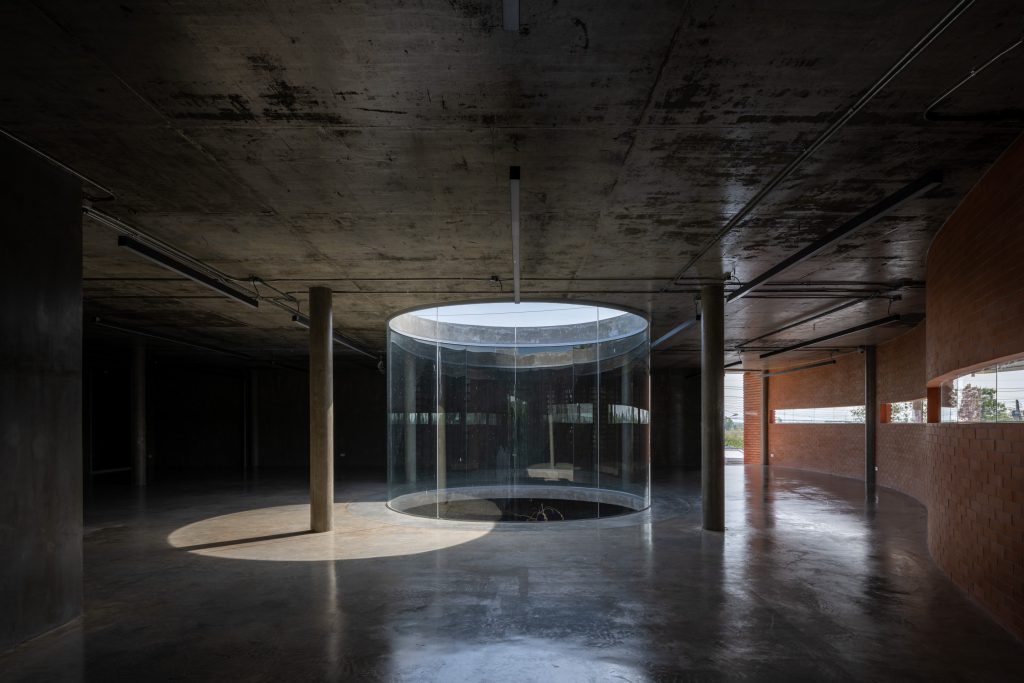
I sense a Threshold: Light to Silence, Silence to Light – an ambiance of inspiration, in which the desire to be, to express, crosses with the possible Light to Silence, Silence to Light crosses in the sanctuary of art.
The previous statement is what legendary American architect, Louis I. Kahn, once said about the merits of light and shadow in architecture, emphasizing the symbolic perception of architecture as a built structure with assigned functionalities and artistic values, all of which are enhanced by the presence of light and shadow. When it comes to the discussion about light and architecture, lighting design is one of the most critical and influential components that complement the spaces, forms and materials of architecture into a collective phenomenon. Within the spaces, the architecture embraces conceived lighting characteristics that are natural and varied by time. This natural light exists alongside artificial lighting whose effects and sources are predetermined according to a designer’s intention and preferences.
Once the architecture is used, the determination of the characteristics of openings, walls, enclosed parts and sections, affect how lights and shadows interact with different material surfaces. In that precise moment, the architecture no longer keeps its silence and begins to converse with its users, as a built structure that cannot be experienced merely through photographs or the screen of a smartphone, but in person, at a specific place and time when light casts its spell. That is when our sensory perceptions toward a space occurs. Such a phenomenon can be found at a newly constructed rice mill situated in the middle of a vast land of rice fields in Nakhon Sawan province, Thailand.
The expansive rice field looks almost infinite. Trucks carrying paddy, making their turns around the corner transporting a massive amount of harvested produce into the mill, is a familiar sight for the locals. The paddy would later be processed and sold before making its way to the consumers as a part of their everyday meals. In the middle of the seemingly boundless terrain of rice fields of Nakhon Sawan, the province that is home to a huge delta known as ‘Pak Nam Pho’ (the Pho Delta) and one of central Thailand’s most prolific sources of agricultural products, not far from the area where Ping and Nan Rivers merge and become the source of Chao Phraya River, or 47 kilometers to the east from the city center, to be exact, sits a large rice mill that restlessly welcomes the coming and going of trucks loaded with harvested paddy.
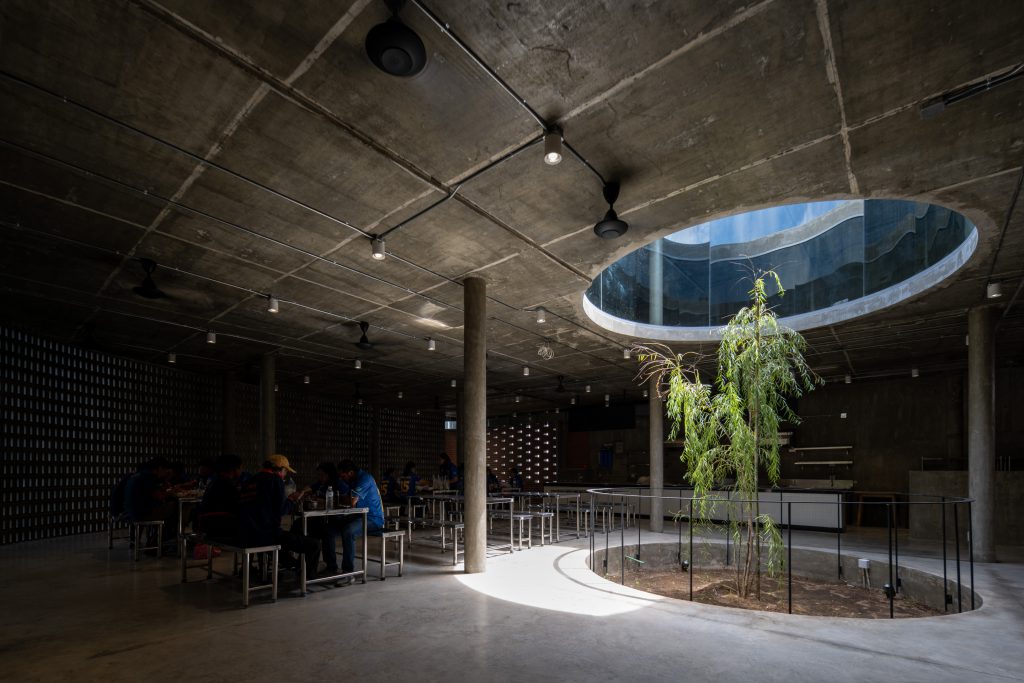
Lorpoonpol Rice Mill is one of Nakhon Sawan’s most prominent rice mills with a 500-tons-per-hour milling capacity. The establishment is the hub of agricultural produce grown in and harvested from the nearby area, functioning as a significant mediator that brings products of local farmers to consumers. For Lorpoonpol Rice Mill, the past recent years were an important time of their business as the establishment was going through a transition where the owners were passing the torch to their younger generation successors. The change is one of the main reasons behind the conception of the project. Ponwit Ratanatanatevilai, architect of PHTAA Living design, talks about the challenges in the design aspect that came with Lorpoonpol Rice Mill project after being assigned to turn the owner’s vision into reality. One of the initial intentions of the owner was to preserve the old building structure for the sentimental value it holds. The old commercial building was formerly used as a multifunctional structure, housing an office space and laboratory where rice quality testing was done. With the architect being informed about the requirements, the design works to compromise the preservation of the old building and the arrival of the newly constructed structure in a unique manner. The distinctive architectural characteristics enable the new architectural structure to coexist with the surrounding environment and context while still being able to accommodate the space’s current and possible future functional requirements.
The design team looks into the site’s previously existing problems such as the circulation, the humidity level of the building’s interior, and severe flood that occurs during the rainy season when water overflows from the river into the property, including rice dust, which is a product of rice milling process. The new design solves the circulation issue by dividing the main building into two floors and expanding the new structure to extend from the old structure toward the north and the east, surrounding the reservoir located to the north of the land. The southern section of the building houses the weighing area accommodating the incoming trucks loaded with harvested produce. The first portion of the space is where the rice is tested for their quality, relative humidity, etc. with the mill’s staff overseeing all the operations. It also houses a waiting area for the farmers while they wait for their products to be tested. Designed to connect with the canteen, the area is used the most in November, which is the year-end’s harvest season. The office still uses the space inside the old building while the new structure on the second floor houses the studio, storage, and certain departments of the office, including an additional space designed for future usage. The building orientation locates the back of the building next to the reservoir, with a presence of large walls of perforated blocks that help dictate the direction of wind flowing inside the interior spaces. This particular part of the space shares certain characteristics with the cafeteria, which is designed into a series of alternating presence of brick walls and vents to maximize air ventilation efficiency while enhancing users’ spatial experience, especially for the staff who use the riverside space after working hours.
The design team comes up with the solution for the humidity issue with the ’Triangular shape brick,’ specifically developed to be the principal material of the building with the ability to reduce humidity and rice dust, which are some of the most important problems of the project. The high humidity is caused by heavy and constant rain, a common characteristics of the area’s low terrain and local climate. The use of triangular shaped bricks reduces the risk of water flowing back into the grout joints, consequently preventing humidity caused by the leaked water in the building’s interior. The brick also offers the humidity prevention attributes, particularly for the laboratory where rice’s quality testing is done. This zone is required to have low humidity in order for the humidity test to be done with highest level of accuracy. Another distinctive feature that the material brings is lessened rice dust on the surface area, especially on the bottom part of the bricks. For those who are wondering about the cost, the bricks are cheaper than autoclaved aerated concrete blocks and cast concrete. The bricks are also locally made material produced by a manufacturer within the nearby province. The design team also ordered handmade A. P.K. brick tiles from another local manufacturer in the area to eliminate high transportation costs.
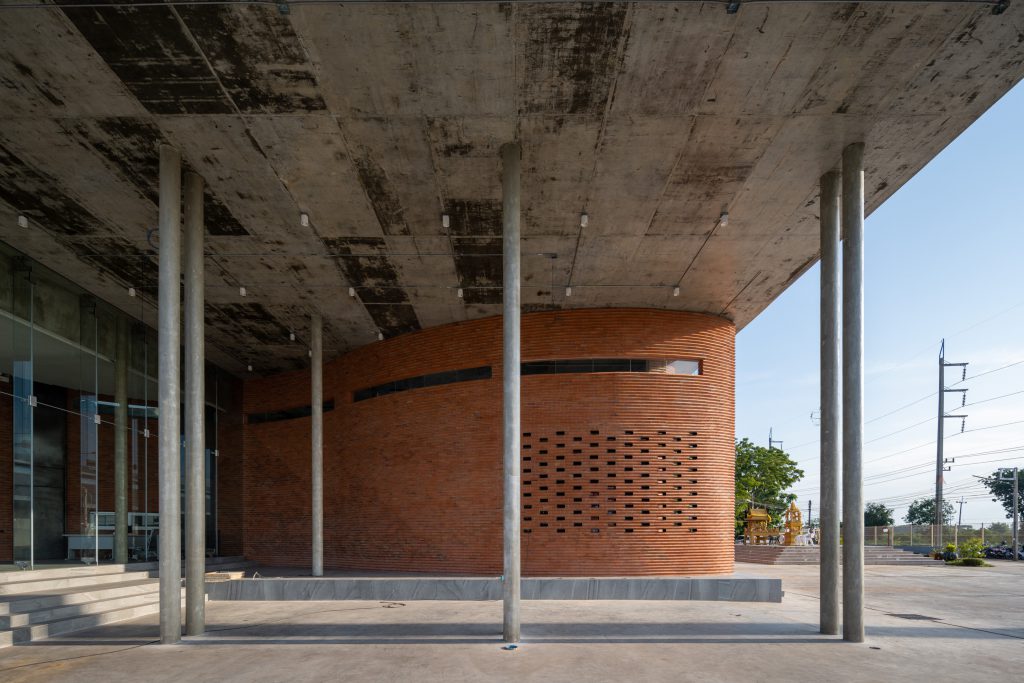
The use of triangular shaped bricks to construct the walls of such relatively large scale creates a unique elevation, and generates dynamic interactions and phenomenon between the architecture and light and shadow at each time of day. For instance, the sunlight casting on the surface renders a series of horizontal lines on the triangular shaped brick walls. The design team chooses to reveal the unique section of the walls, showcasing the masonry details of how the bricks are laid, and the section of the material. The interior lighting is designed to emphasize a lighting phenomenon in which a ray of light comes through a circular skylight situated in the middle of the program of both the upper and ground floor. The trees growing inside this tube of light create an ambience of indirect lighting, which becomes a key lighting characteristic of the project’s interior spaces. The design team determines the calculated placements of light openings on the solid masses of the walls. The design team’s solution to manipulate natural light and empty spaces of the interior program also ends up preventing the interior functional space from gathering rice dust caused by rice milling process and the humidity, which is a result of the area’s rainy climate. At the same time, the design brings interesting aesthetic characteristics of light and shadow to both the interior and exterior spaces through the masterfully designed and constructed brick walls.
The upper part of the facade is built using perforated aluminum sheets to cover the old structure. The sheets are designed to deviate and enhance ventilation, preventing dust collection. Another reason behind the decision to use this specific type of aluminum sheet comes from the architect’s intention for the material to help prevent birds from nesting and invading the upper part of the facade’s structure. With the intense sunlight during the day, the sheets end up becoming too hot for birds to nest. As the sun casts its light on the surface at different times of day, revealed is the building and its brick walls situated in one perfect and unique harmony, in the middle of the vast, seemingly infinite green fields. The new mill in an old space represents, not only a beautiful transition between different generations, but also the relationship between architecture, and the culture and landscape of Pak Nam Pho.


